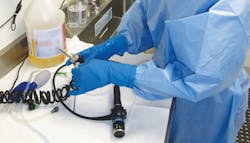Mitigating risk in flexible endoscope reprocessing
Historically, the frames of reference for flexible endoscope reprocessing have been paid attention to in “silos,” depending on the clinical department/staff involved. Most GI endoscopy areas focused primarily (if not all) on SGNA and ASGE’s “Multisociety Guidelines.”1 For example, if one worked in the Operating Room (OR), they referenced AORN. If they were in a Central Sterile Processing and Distribution (CSPD) area, it was AAMI or IAHCSMM. This has served to foster further “siloing” of thought, expectations and actual practice. When misses and near-misses arise – and more than one of these areas are involved – a lack of cohesiveness and common ground can emerge.So how does one navigate this within healthcare institutions – to limit confusion, concern, and ultimately risk?
Little by little, the major organizations that produce the standards and guidelines are coming together on key content, especially related to quality control and evidenced-based practice recommendations. For years, the “Multisociety Guidelines” spoke for multiple professional organizations – including those for GI Physicians and Nurses, Infection Prevention and Epidemiology. This served as the main reference point for flexible endoscope reprocessing. Since 2015, AAMI’s ST91 document has additionally incorporated the voices of AORN, IAHCSMM, device manufacturers, regulatory agencies and clinical users. The real benefit to the front-line customer is that the various guidelines are more complementary than in the past. This is not to say that different interpretations and recommendations don’t exist. For example, direction for endoscope “hang time” varies between organizations.
The past several years has also brought an increased and more consistent tendency for accreditation surveys to more than ever focus on device reprocessing with special emphasis on flexible endoscope reprocessing. As governmental and regulatory agencies, standards organizations and professional societies have responded with modified and/or more prescriptive reprocessing expectations, we see this routinely reflected in successive accreditation surveys. This, in turn, forces practice change. As a result, healthcare institutions need to keep abreast of these evolving standards and guidelines. This has prompted industry to respond – more than ever before – with continuing education, focusing on reprocessing and infection control. For all concerned, it’s important to know how to approach this.
Start at the top
Where should facilities start in making sure practices reflect standards and guidelines, and in turn, establishing best practice?
The first step is one of the biggest – gathering together key stakeholders. These should minimally include primary clinical users of flexible endoscopes (Endo, OR), reprocessing (hospital-based as well as ambulatory care), Infection Prevention, Safety, Accreditation and Administration. The first task then is for this interdisciplinary team to discover and decide the national standards and guidelines on which they will base their endoscope reprocessing practices. They need to make sure they reference the most current standards. As they will be surveyed in total as an organization, practices need to be standardized across the institution.
Negotiate around conflicts
With that, in this early stage, they need to resolve any conflicts. These include conflicts in detail between standards (e.g., endoscope “hang time”) and conflicts in practices between their clinical sites. It is okay, for example, to reference AAMI, SGNA and AORN, but the institution’s written policy for endoscope reprocessing needs to be clear in areas where the standards differ. All sites that perform any part of reprocessing within that institution then need to base practices on the resulting written policies.
Either before or as these written practice expectations are established, the organization needs to conduct an assessment of current state and gap analysis across the institution. This should influence the interdisciplinary decision making. For example, if the ENT clinic is discovered to perform as many or more procedures per day than the OR, they need to be “at the table.” If more complex endoscope procedures are performed (e.g., ERCP or EUS), policies need to reflect that level of complexity. If practices related to pre-cleaning are extremely varied or non-existent, then written policy and education need to be that much more definitive in expected practice. If discovery shows multiple chemical disinfectants across the institution, then it also identifies a need to standardize. If inventory reviews show a fleet of old devices, then that signals potential risk. Current-state assessments also help identify opportunities to consolidate or eliminate sites.
Results from these assessments and gap analyses should be reviewed through the interdisciplinary team – and to include administration. The institution’s leadership must be engaged in and support this project. This is instrumental when it comes to needing resources or a supporting voice for change. Ultimately, the leadership of the organization will be held accountable for any deficiencies within the institution.
From these discussions, the team prioritizes efforts and creates an implementation plan. It sets goals and targets. Inevitably, there will be multiple issues to address, and there is no effective or sustainable way to change everything at once. Some changes will lend themselves to a “just do it” approach; others will require more engagement and time. What’s key is the education and re-education of staff. This may take several forms, depending on the critical nature or complexity – e.g., in-services, message blitzes, one-to-one retraining. A common obstacle that surfaces is the “we’ve always done it this way” mentality. Emphasis should be on providing rationale for new or different practices, as opposed to taking a punitive or threatening approach.
Whenever changes are made, follow-up assessments need to occur, and a system for periodic site visits, tracers and gap analyses will need to be established to ensure ongoing compliance. The support of leadership and the interdisciplinary approach lead to success for change.
A lot of effort is required to address system gaps and reset expectations, but the burden is lessened when it involves a team of representative stakeholders at work. This sets the foundation for the ongoing work of evaluating and re-evaluating practice. This approach also makes the job easier when issues do arise, such as those misses and near-misses. All the work done to establish foundational standards, guidelines and policies will continually serve as the “guideposts” for the risk analyses and event reviews yet to come.
1 https://www.asge.org/docs/default-source/education/practice_guidelines/2016_ms_reprocessing_flexible_endoscopes.pdf?sfvrsn=8
About the Author

John Whelan
Clinical Education Coordinator
John Whelan, R.N., is Clinical Education Coordinator for Healthmark Industries
